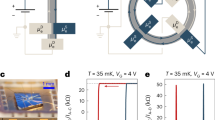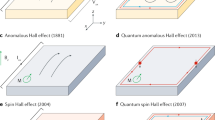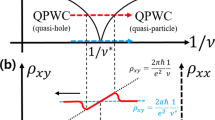Abstract
The quantum anomalous Hall effect (QAHE)1,2,3,4,5,6 is a transport phenomenon where the Hall resistance is quantized to the von Klitzing constant due to the spontaneous magnetization of a ferromagnetic material even at zero magnetic field. Similar to the quantum Hall effect (QHE) under strong magnetic fields, the quantized Hall resistance of QAHE is supposed to be universal, independent of the details in the experimental realization7,8. However, the quantization accuracy of QAHE reported so far9,10,11 is much poorer than that of QHE. Here we demonstrate a precision of 10 parts per billion of Hall resistance quantization in QAHE. By directly comparing QAHE with QHE, we confirm that the quantization accuracy of QAHE satisfies the required level as a primary standard of electric resistance. We achieve this high accuracy of quantization by using a weak magnetic field supplied by a permanent disc magnet to align the magnetization domains. Our findings establish a milestone for developing a quantum resistance standard without strong magnetic fields.
This is a preview of subscription content, access via your institution
Access options
Access Nature and 54 other Nature Portfolio journals
Get Nature+, our best-value online-access subscription
$29.99 / 30 days
cancel any time
Subscribe to this journal
Receive 12 print issues and online access
$209.00 per year
only $17.42 per issue
Buy this article
- Purchase on Springer Link
- Instant access to full article PDF
Prices may be subject to local taxes which are calculated during checkout




Similar content being viewed by others
Data availability
Source data are provided with this paper. The data that support the findings of this study are available from the corresponding authors on reasonable request.
References
Yu, R. et al. Quantized anomalous Hall effect in magnetic topological insulators. Science 329, 61–64 (2010).
Chang, C.-Z. et al. Experimental observation of the quantum anomalous Hall effect in a magnetic topological insulator. Science 340, 167–170 (2013).
Checkelsky, J. G. et al. Trajectory of the anomalous Hall effect towards the quantized state in a ferromagnetic topological insulator. Nat. Phys. 10, 731–736 (2014).
Kou, X. et al. Scale-invariant quantum anomalous Hall effect in magnetic topological insulators beyond the two-dimensional limit. Phys. Rev. Lett. 113, 199901 (2014).
Chang, C.-Z. et al. High-precision realization of robust quantum anomalous Hall state in a hard ferromagnetic topological insulator. Nat. Mater. 14, 473–477 (2015).
Bestwick, A. J. et al. Precise quantization of the anomalous Hall effect near zero magnetic field. Phys. Rev. Lett. 114, 187201 (2015).
Jeckelmann, B. & Jeanneret, B. The quantum Hall effect as an electrical resistance standard. Rep. Prog. Phys. 64, 1603–1655 (2001).
Poirier, W. & Schopfer, F. Resistance metrology based on the quantum Hall effect. Eur. Phys. J. Spec. Top. 172, 207–245 (2009).
Götz, M. et al. Precision measurement of the quantized anomalous Hall resistance at zero magnetic field. Appl. Phys. Lett. 112, 072102 (2018).
Fox, E. J. et al. Part-per-million quantization and current-induced breakdown of the quantum anomalous Hall effect. Phys. Rev. B 98, 075145 (2018).
Okazaki, Y. et al. Precise resistance measurement of quantum anomalous Hall effect in magnetic heterostructure film of topological insulator. Appl. Phys. Lett. 116, 143101 (2020).
Stock, M., Davis, R., de Mirandés, E. & Milton, M. J. T. The revision of the SI—the result of three decades of progress in metrology. Metrologia 56, 022001 (2019).
von Klitzing, K., Dorda, G. & Pepper, M. New method for high-accuracy determination of the fine-structure constant based on quantized Hall resistance. Phys. Rev. Lett. 45, 494–497 (1980).
Thouless, D. J., Kohmoto, M., Nightingale, M. P. & den Nijs, M. Quantized Hall conductance in a two-dimensional periodic potential. Phys. Rev. Lett. 49, 405–408 (1982).
Kohmoto, M. Topological invariant and the quantization of the Hall conductance. Ann. Phys. 160, 343–354 (1985).
Schopfer, F. & Poirier, W. Testing universality of the quantum Hall effect by means of the Wheatstone bridge. J. Appl. Phys. 102, 054903 (2007).
Tzalenchuk, A. et al. Towards a quantum resistance standard based on epitaxial graphene. Nat. Nanotechnol. 5, 186–189 (2010).
Ribeiro-Palau, R. et al. Quantum Hall resistance standard in graphene devices under relaxed experimental conditions. Nat. Nanotechnol. 10, 965–971 (2015).
Lafont, F. et al. Quantum Hall resistance standards from graphene grown by chemical vapour deposition on silicon carbide. Nat. Commun. 6, 6806 (2015).
Panna, A. R. et al. Graphene quantum Hall effect parallel resistance arrays. Phys. Rev. B 103, 075408 (2021).
Scherer, H. & Camarota, B. Quantum metrology triangle experiments: a status review. Meas. Sci. Technol. 23, 124010 (2012).
Kaneko, N.-H., Nakamura, S. & Okazaki, Y. A review of the quantum current standard. Meas. Sci. Technol. 27, 032001 (2016).
Delahaye, F. & Jeckelmann, B. Revised technical guidelines for reliable d.c. measurements of the quantized Hall resistance. Metrologia 40, 217–223 (2003).
Mogi, M. et al. Magnetic modulation doping in topological insulators toward higher-temperature quantum anomalous Hall effect. Appl. Phys. Lett. 107, 182401 (2015).
Kawamura, M. et al. Current-driven instability of the quantum anomalous Hall effect in ferromagnetic topological insulators. Phys. Rev. Lett. 119, 016803 (2017).
Pan, L. et al. Probing the low-temperature limit of the quantum anomalous Hall effect. Sci. Adv. 6, eaaz3595 (2020).
Witt, T. J. Using the Allan variance and power spectral density to characterize d.c. nanovoltmeters. IEEE Trans. Instrum. Meas. 50, 445–448 (2001).
Ou, Y. et al. Enhancing the quantum anomalous Hall effect by magnetic codoping in a topological insulator. Adv. Mater. 30, 1703062 (2018).
Katmis, F. et al. A high-temperature ferromagnetic topological insulating phase by proximity coupling. Nature 533, 513–516 (2016).
Mogi, M. et al. Large anomalous Hall effect in topological insulators with proximitized ferromagnetic insulators. Phys. Rev. Lett. 123, 016804 (2019).
Watanabe, R. et al. Quantum anomalous Hall effect driven by magnetic proximity coupling in all-telluride based heterostructure. Appl. Phys. Lett. 115, 102403 (2019).
Deng, Y. et al. Quantum anomalous Hall effect in intrinsic magnetic topological insulator MnBi2Te4. Science 367, 895–900 (2020).
Liu, C. et al. Robust axion insulator and Chern insulator phases in a two-dimensional antiferromagnetic topological insulator. Nat. Mater. 19, 522–527 (2020).
Sharpe, A. L. et al. Emergent ferromagnetism near three-quarters filling in twisted bilayer graphene. Science 365, 605–608 (2019).
Serlin, M. et al. Intrinsic quantized anomalous Hall effect in a moiré heterostructure. Science 367, 900–903 (2019).
BIPM Key Comparison Database. https://www.bipm.org/kcdb/comparison?id=430 (2021).
Delahaye, F. Series and parallel connection of multiterminal quantum Hall-effect devices. J. Appl. Phys. 73, 7914–7920 (1993).
Acknowledgements
This research was supported by JST CREST (no. JPMJCR16F1 (M. Kawasaki)); MEXT/JSPS KAKENHI grant nos. JP15H05867 (M. Kawamura), JP15H05853 (A.T.), JP17H04846 (R.Y.), JP18H04229 (R.Y.), JP18H01155 (M. Kawamura), JP18H01156 (Y.O.) and JP18H05258 (N.-H.K.); and RIKEN-AIST Joint Research Fund (Y.O. and M. Kawamura).
Author information
Authors and Affiliations
Contributions
Y.T. and N.-H.K. conceived the project. R.Y. and M. Kawamura fabricated the QAHE samples and characterized their general transport properties with the help of M.M., K.S.T., A.T. and M. Kawasaki. Y.O. conducted the precision measurements and data analysis with the assistance of T.O., S.N. and S.T. Y.O. and M. Kawamura wrote the draft. All the authors discussed the results and commented on the manuscript.
Corresponding authors
Ethics declarations
Competing interests
The authors declare no competing interests.
Additional information
Peer review information Nature Physics thanks the anonymous reviewers for their contribution to the peer review of this work
Publisher’s note Springer Nature remains neutral with regard to jurisdictional claims in published maps and institutional affiliations.
Extended data
Extended Data Fig. 1 Device Structure.
Photo-mask pattern of the mesa and the Ohmic contacts for the 800 μm-wide Hall bar device.
Extended Data Fig. 2 Transport properties of the FMTI film.
a, Optical microscope image of a 400 μm-wide Hall bar. S, D, and G denote source, drain contacts and a top-gate electrode, respectively. Vy was measured between the electrodes U2 and L2, and Vx was measured between L2 and L3. b, Gate voltage dependence of ρyx and ρxx with a measurement current I = 1.0 μA. The data were taken at B = 0 T after magnetizing the sample at B = 1.0 T. The value of ρxx was multiplied by 10 for clarity. c, d, Field- and zero-field cooling traces of ρyx and ρxx. Magnetic field B = 0.2 T in the field cooling measurement.
Extended Data Fig. 3 Gate dependence of ρxx.
Gate voltage VG dependence of ρxx measured at I = 0.5 μA using the upper pair of the voltage contacts (U1-U5) of the 800 μm-wide Hall bar device. The values of ρxx are suppressed around − 2 V < VG < 0.5 V, indicating that the QAHE is well developed at VG = 0 V. Note that the measurement was performed below 0.5 V because a relatively large gate leakage was observed above 1.0 V.
Extended Data Fig. 4 One-to-one resistance bridge between the two QHEs.
a, b, Simplified circuit diagrams in the normal (a) and swapped (b) configurations. Here RX is RQAHE (RQHE1) and RS is RQHE1 + RQHE2(RQHE2) for the QAHE-QHE (QHE-QHE) comparison. c, Detailed circuit diagram of the resistance bridge for the comparison between QHE1 and QHE2.
Extended Data Fig. 5 Measurement sequence.
Single batch on-off sequence of the current I and the resulting measured voltage difference Vd. The current ramping rate was 0.16 μA/s. In the measurements of Fig. 4a, the single batch of the sequence took 45 s for I = 0.8 μA, and it took about 110 hours in total [45 s (single batch) × 2200 (number of points) × 2 (current polarity change) × 2 (circuit swapping)].
Extended Data Fig. 6 Uncertainty evaluation.
Relative uncertainty from possible source components in the normalized deviation ΔR/RK for the QAHE-QHE comparison with N = 2200 and I = 0.8 μA, and for the QHE-QHE comparison with N = 50 and I = 10 μA. In both cases, the dominant component of the uncertainty is dispersion from random effect.
Extended Data Fig. 7 Comparison of the relevant parameters.
Material: the materials and the layer structure of the FMTI film (the capping layer and the gate electrode are omitted for clarity). ΔR/RK: the normalized deviation in the values of the quantized anomalous Hall resistance. The current value I used for the precise measurement is also appended. (*Hall resistance measurements performed at I = 0.005 μA and 0.01 μA. **obtained by averaging the Hall resistance measurements for I < 0.09 μA.) W: Hall bar width. T0: activation energy (***measured in the 400 μm-wide Hall bar as described in Methods). ρxx: longitudinal resistivity. Method: experimental technique for the precision measurement of the Hall resistance.
Source data
Source Data Fig. 2
Numerical source data for Fig. 2.
Source Data Fig. 3
Numerical source data for Fig. 3c.
Source Data Fig. 4
Numerical source data for Fig. 4.
Rights and permissions
About this article
Cite this article
Okazaki, Y., Oe, T., Kawamura, M. et al. Quantum anomalous Hall effect with a permanent magnet defines a quantum resistance standard. Nat. Phys. 18, 25–29 (2022). https://doi.org/10.1038/s41567-021-01424-8
Received:
Accepted:
Published:
Issue Date:
DOI: https://doi.org/10.1038/s41567-021-01424-8
This article is cited by
-
A balanced quantum Hall resistor
Nature Electronics (2024)
-
Direct visualization of electronic transport in a quantum anomalous Hall insulator
Nature Materials (2023)
-
High Chern number van der Waals magnetic topological multilayers MnBi2Te4/hBN
npj 2D Materials and Applications (2023)
-
General nonlinear Hall current in magnetic insulators beyond the quantum anomalous Hall effect
Nature Communications (2023)
-
Chiral edge state coupling theory of transport in quantum anomalous Hall insulators
Science China Physics, Mechanics & Astronomy (2023)



